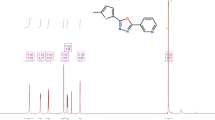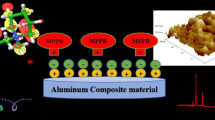Abstract
In order to understand the chemical speciation of 2-mercaptobenzothiazole (MBT) corrosion inhibitor as a function of pH, the experimental electronic absorption spectra was compared with those calculated at the EOM-CCSD, TD-M06-2X and TD-B3LYP levels of theory for several different species that may result from MBT reactions in aqueous solution. The computational spectroscopic analysis was supported by the energetics of tautomerization, deprotonation, non-covalent association and ion-pair formation reactions calculated at the M06-2X/6-31++G(d,p) level of theory. The thioketonic and deprotonated anionic forms of MBT were found to be the main species depending on the pH, while the formation of the ion-pair was also supported under basic conditions, especially when put in perspective of the release profiles of the inhibitor from nanocontainers published in the literature. The calculated energetic and electronic results were used to unveil the tautomeric, acid–base and ion-pair formation equilibrium, relevant to guide the application of MBT as a corrosion inhibitor, and establishing a foundation for future molecular modeling studies concerning the adsorption of MBT onto metal and metal alloys under different pHs.









Similar content being viewed by others
References
Gholami M, Danaee I, Maddahy MH, RashvandAvei M (2013) Correlated ab initio and electroanalytical study on inhibition behavior of 2-mercaptobenzothiazole and its thiole–thione tautomerism effect for the corrosion of steel (API 5L X52) in sulphuric acid solution. Ind Eng Chem Res 52:14875–14889. doi:10.1021/ie402108g
Shervedani RK, Hatefi-Mehrjardi A, Babadi MK (2007) Comparative electrochemical study of self-assembled monolayers of 2-mercaptobenzoxazole, 2-mercaptobenzothiazole, and 2-mercaptobenzimidazole formed on polycrystalline gold electrode. Electrochim Acta 52:7051–7060. doi:10.1016/j.electacta.2007.05.030
Shchukin DG, Zheludkevich M, Yasakau K et al (2006) Layer-by-layer assembled nanocontainers for self-healing corrosion protection. Adv Mater 18:1672–1678. doi:10.1002/adma.200502053
Zheludkevich ML, Tedim J, Ferreira MGS (2012) “Smart” coatings for active corrosion protection based on multi-functional micro and nanocontainers. Electrochim Acta 82:314–323. doi:10.1016/j.electacta.2012.04.095
Bastos AC, Karavai OV, Zheludkevich ML et al (2010) Localised measurements of pH and dissolved oxygen as complements to SVET in the investigation of corrosion at defects in coated aluminum alloy. Electroanalysis 22:2009–2016. doi:10.1002/elan.201000076
Shchukin DG, Lamaka SV, Yasakau KA et al (2008) Active anticorrosion coatings with halloysite nanocontainers. J Phys Chem C 112:958–964. doi:10.1021/jp076188r
Poznyak SK, Tedim J, Rodrigues LM et al (2009) Novel inorganic host layered double hydroxides intercalated with guest organic inhibitors for anticorrosion applications. ACS Appl Mater Interfaces 1:2353–2362. doi:10.1021/am900495r
Tedim J, Poznyak SK, Kuznetsova A et al (2010) Enhancement of active corrosion protection via combination of inhibitor-loaded nanocontainers. ACS Appl Mater Interfaces 2:1528–1535. doi:10.1021/am100174t
Maia F, Tedim J, Lisenkov AD et al (2012) Silica nanocontainers for active corrosion protection. Nanoscale 4:1287. doi:10.1039/c2nr11536k
Abdullayev E, Abbasov V, Tursunbayeva A et al (2013) Self-healing coatings based on halloysite clay polymer composites for protection of copper alloys. ACS Appl Mater Interfaces 5:4464–4471. doi:10.1021/am400936m
Borisova D, Akçakayiran D, Schenderlein M et al (2013) Nanocontainer-based anticorrosive coatings: effect of the container size on the self-healing performance. Adv Funct Mater 23:3799–3812. doi:10.1002/adfm.201203715
Lv LP, Landfester K, Crespy D (2014) Stimuli-selective delivery of two payloads from dual responsive nanocontainers. Chem Mater 26:3351–3353. doi:10.1021/cm500923d
Carneiro J, Caetano AF, Kuznetsova A et al (2015) Polyelectrolyte-modified layered double hydroxide nanocontainers as vehicles for combined inhibitors. RSC Adv 5:39916–39929. doi:10.1039/C5RA03741G
Jun YY, Beng KS (2004) Electrochemical study of monolayers of heterocyclic thiols self-assembled on polycrystalline gold electrode: the effect of solution pH on redox kinetics. Electrochem Commun 6:87–90. doi:10.1016/j.elecom.2003.10.023
Breedon M, Per MC, Cole IS, Barnard AS (2014) Molecular ionization and deprotonation energies as indicators of functional coating performance. J Mater Chem A 2:16660–16668. doi:10.1039/C4TA03414G
Winkler DA, Breedon M, Hughes AE et al (2014) Towards chromate-free corrosion inhibitors: structure–property models for organic alternatives. Green Chem 16:3349. doi:10.1039/c3gc42540a
Rajasekharan-Nair R, Moore D, Kennedy AR et al (2014) The stability of mercaptobenzothiazole based soft scorpionate complexes. Inorg Chem 53:10276–10282. doi:10.1021/ic5013236
Herrera Cano N, Ballari MS, López AG, Santiago AN (2015) New synthesis and biological evaluation of benzothiazole derivates as antifungal agents. J Agric Food Chem 63:3681–3686. doi:10.1021/acs.jafc.5b00150
Ilichev VA, Pushkarev AP, Rumyantcev RV et al (2015) Luminescent properties of 2-mercaptobenzothiazolates of trivalent lanthanides. Phys Chem Chem Phys 17:11000–11005. doi:10.1039/C4CP05928J
Altun A, Kuliyev E, Aghatabay NM (2016) Tautomeric conversion, vibrational spectra, and density functional studies on peripheral sulfur derivatives of benzothiazole and benzothiazoline isomers. Spectrochim Acta Part A Mol Biomol Spectrosc 152:181–191. doi:10.1016/j.saa.2015.07.071
Serdechnova M, Ivanov VL, Domingues MRM et al (2014) Photodegradation of 2-mercaptobenzothiazole and 1,2,3-benzotriazole corrosion inhibitors in aqueous solutions and organic solvents. Phys Chem Chem Phys 16:25152–25160. doi:10.1039/C4CP03867C
Wang G, Harrison A, Li X et al (2004) Study of the adsorption of benzimidazole and 2-mercaptobenzothiazole on an iron surface by confocal micro-Raman spectroscopy. J Raman Spectrosc 35:1016–1022. doi:10.1002/jrs.1235
Sandhyarani N, Skanth G, Berchmans S et al (1999) A combined surface-enhanced Raman-X-ray photoelectron spectroscopic study of 2-mercaptobenzothiazole monolayers on polycrystalline Au and Ag films. J Colloid Interface Sci 209:154–161. doi:10.1006/jcis.1998.5882
Malouki MA, Richard C, Zertal A (2004) Photolysis of 2-mercaptobenzothiazole in aqueous medium: laboratory and field experiments. J Photochem Photobiol A Chem 167:121–126. doi:10.1016/j.jphotochem.2004.04.010
Masoud MS, Abou Ali SA, Ali GY, El-Dessouky MA (1983) Substituent effects on the dissociation constants and the strength of the hydrogen bond in some azo cresol compounds. J Chem Eng Data 28:297–300. doi:10.1021/je00033a004
Isidro-Llobet A, Just-Baringo X, Ewenson A et al (2007) Fmoc-2-mercaptobenzothiazole, for the introduction of the Fmoc moiety free of side-reactions. Biopolymers 88:733–737. doi:10.1002/bip.20732
Frisch MJ, Trucks GW, Schlegel HB et al (2009) Gaussian 09, Rev A.1. Gaussian Inc Wallingford CT
Zhao Y, Truhlar DG (2008) The M06 suite of density functionals for main group thermochemistry, thermochemical kinetics, noncovalent interactions, excited states, and transition elements: two new functionals and systematic testing of four M06-class functionals and 12 other function. Theor Chem Acc 120:215–241. doi:10.1007/s00214-007-0310-x
Tomasi J, Mennucci B, Cammi R (2005) Quantum mechanical continuum solvation models. Chem Rev 105:2999–3093. doi:10.1021/cr9904009
Scalmani G, Frisch MJ, Mennucci B et al (2006) Geometries and properties of excited states in the gas phase and in solution: theory and application of a time-dependent density functional theory polarizable continuum model. J Chem Phys 124:94107. doi:10.1063/1.2173258
Becke AD (1993) Density-functional thermochemistry. III. The role of exact exchange. J Chem Phys 98:5648. doi:10.1063/1.464913
Stanton JF, Bartlett RJ (1993) The equation of motion coupled-cluster method. A systematic biorthogonal approach to molecular excitation energies, transition probabilities, and excited state properties. J Chem Phys 98:7029. doi:10.1063/1.464746
Kállay M, Gauss J (2004) Calculation of excited-state properties using general coupled-cluster and configuration-interaction models. J Chem Phys 121:9257–9269. doi:10.1063/1.1805494
Caricato M, Trucks GW, Frisch MJ, Wiberg KB (2010) Electronic transition energies: a study of the performance of a large range of single reference density functional and wave function methods on valence and Rydberg states compared to experiment. J Chem Theory Comput 6:370–383. doi:10.1021/ct9005129
Caricato M, Trucks GW, Frisch MJ, Wiberg KB (2011) Oscillator strength: How does TDDFT compare to EOM-CCSD? J Chem Theory Comput 7:456–466. doi:10.1021/ct100662n
Caricato M (2012) Absorption and emission spectra of solvated molecules with the EOM-CCSD-PCM method. J Chem Theory Comput 8:4494–4502. doi:10.1021/ct3006997
Boys SF, Bernardi F (1970) The calculation of small molecular interactions by the differences of separate total energies. Some procedures with reduced errors. Mol Phys 19:553–566. doi:10.1080/00268977000101561
Simon S, Duran M, Dannenberg JJ (1996) How does basis set superposition error change the potential surfaces for hydrogen-bonded dimers? J Chem Phys 105:11024. doi:10.1063/1.472902
Shields GC, Seybold PG (2013) Computational approaches for the prediction of pK a values. CRC Press, Boca Raton
McQuarrie DA, Simon JD (1997) Physical chemistry: a molecular approach. University Science Books, Sausalito
Palascak MW, Shields GC (2004) Accurate experimental values for the free energies of hydration of H+, OH−, and H3O+. J Phys Chem A 108:3692–3694. doi:10.1021/jp049914o
Chesick JP, Donohue J (1971) The molecular and crystal structure of 2-mercaptobenzothiazole. Acta Crystallogr Sect B Struct Crystallogr Cryst Chem 27:1441–1444. doi:10.1107/S0567740871004102
Zhang J, Li F, Zhang R (2004) Syntheses and crystal structures of Benzyltin(IV) derivatives of 2-merpcatobenzothiazole. Chin J Chem 22:2775–2783. doi:10.1002/ejic.200300860
Bordwell FG (1988) Equilibrium acidities in dimethyl sulfoxide solution. Acc Chem Res 21:456–463. doi:10.1021/ar00156a004
Poznański J, Najda A, Bretner M, Shugar D (2007) Experimental (13C NMR) and theoretical (ab Initio molecular orbital calculations) studies on the prototropic tautomerism of benzotriazole and some derivatives symmetrically substituted on the benzene ring. J Phys Chem A 111:6501–6509. doi:10.1021/jp071611h
Houllihan WJ (1972) The chemistry of heterocyclic compounds. Wiley-Interscience, Indoles Part One
Serjeant E (1979) Ionisation constants of organic acids in aqueous solution. Pergamon Press, New York
Foulon C, Duhal N, Lacroix-Callens B et al (2007) Determination of pK a values of benzoxa-, benzothia- and benzoselena-zolinone derivatives by capillary electrophoresis. Comparison with potentiometric titration and spectrometric data. Eur J Pharm Sci 31:165–171. doi:10.1016/j.ejps.2007.03.002
Irudayam SJ, Henchman RH (2009) Entropic cost of protein–ligand binding and its dependence on the entropy in solution. J Phys Chem B 113:5871–5884. doi:10.1021/jp809968p
Irudayam SJ, Henchman RH (2001) Encyclopedia of reagents for organic synthesis. Wiley, New York
Golabi SM, Mohammadi J (2003) Wire-coated silver(I) ion-selective electrode based on 2-mercaptobenzothiazole (MBT) ionophore: application to the determination of silver in real samples. Anal Sci 19:877–881. doi:10.2116/analsci.19.877
Acknowledgments
This work was developed in the scope of the project CICECO—Aveiro Institute of Materials, POCI-01-0145-FEDER-007679 (Ref. FCT UID/CTM/50011/2013), financed by national funds through the FCT/MEC and when applicable co-financed by FEDER under the PT2020 Partnership Agreement. This work is also funded by ERDF Funds through the Regional Operational Program of the Centre—MAIS Centro in the frame of the project FUNACOP—FCOMP-01-0124-FEDER-38777. The authors also thank financial support from FCT and COMPETE (PTDC/CTM-MAT/2502/2012, PTDC/QEQ-QFI/4719/2014 and Programa Investigador FCT). JT thanks FCT for the research Grant IF/00347/2013.
Author information
Authors and Affiliations
Corresponding author
Electronic supplementary material
Below is the link to the electronic supplementary material.
Rights and permissions
About this article
Cite this article
Galvão, T.L.P., Kuznetsova, A., Gomes, J.R.B. et al. A computational UV–Vis spectroscopic study of the chemical speciation of 2-mercaptobenzothiazole corrosion inhibitor in aqueous solution. Theor Chem Acc 135, 78 (2016). https://doi.org/10.1007/s00214-016-1839-3
Received:
Accepted:
Published:
DOI: https://doi.org/10.1007/s00214-016-1839-3




